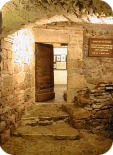If you come to France make sure you take your time to go to the South (sorry, not the Frecnh Riviera, but the Cevennes) and visit The DESERT MUSEUM. The Cévennes is a southern French region , I think 700 km from Paris, with a rich history of protestantism. Most of Historical French Reformed Evangelical Churchs are based in these regions (and in the south east of this region.
 The DESERT MUSEUM brings to life the Huguenot past and the history of the Camisards.
The DESERT MUSEUM brings to life the Huguenot past and the history of the Camisards.Why "The Desert"?
In the history of French Protestantism, the expression Desert defines the period of time between the Revocation of the Edict of Nantes (1685) and the French Revolution (1789).
Deprived of freedom of worship, far from the cities, hidden in isolated areas, deserts (in the wilderness, forests, caves, or gullies…), where the Protestants in France (in the Cevennes, but also in Haut-Languedoc, in Poitou, Dauphiné, Vivarais…) were obligated to live out their faith in hiding.
The word Desert also had a biblical sense for them, the 40 years the Hebrew people of Exodus wandered in the desert, a place of tribulations, temptations and despair, but also where they would hear the word of the Lord.
This chapter of history touches all of France, but specifically the Languedoc region and the Cevennes, where Protestantism was largely established at the beginning of the XVIth century.

The Museum Specifically :
![]() The ‘Desert’ period (1685-1789), from the Revocation of the Edict of Nantes to the French Revolution.
The ‘Desert’ period (1685-1789), from the Revocation of the Edict of Nantes to the French Revolution.
![]() The Camisards war
The Camisards war
![]() Persecutions and resistance.
Persecutions and resistance.
![]() The clandestine life.
The clandestine life.
![]() The long road to freedom of conscience achieved at the French Revolution.
The long road to freedom of conscience achieved at the French Revolution.
It also intends to bear testimony to Protestant faithfulness.
Through fifteen rooms, the Desert Museum presents the following :
![]() Antique furniture and domestic objects from the Cevennes : costumes from the era, a fully equipped authentic XVIIIth century kitchen, products that are grown and fabricated in the region.
Antique furniture and domestic objects from the Cevennes : costumes from the era, a fully equipped authentic XVIIIth century kitchen, products that are grown and fabricated in the region.
![]() A reconstitution of a family evening in the Cevennes.
A reconstitution of a family evening in the Cevennes.
![]() Original weapons and hand-drawn maps from the Camisards war.
Original weapons and hand-drawn maps from the Camisards war.
![]() Hiding places for hunted men and forbidden books.
Hiding places for hunted men and forbidden books.
![]() Authentic documents, manuscripts and prints ; official letters and decrees from the royal powers.
Authentic documents, manuscripts and prints ; official letters and decrees from the royal powers.
![]() Clandestine pulpits, communion cups, birth and marriage certificates.
Clandestine pulpits, communion cups, birth and marriage certificates.
![]() An impressive collection of Bibles and Psalters.
An impressive collection of Bibles and Psalters.
![]() A large collection of paintings and prints.
A large collection of paintings and prints.
This information is taken directly from its web site






Once again, this is brilliant. I hope to visit this museum and the cevennes region some day. I have been to the museum in La Rochelle and enjoyed it very much. Have you been there?
ReplyDelete